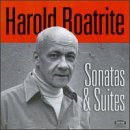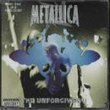| All Artists: Harold Boatrite, Marcantonio Barone, Jennifer Lim, Hugh Sung, David Douglas Bryant Title: Boatrite: Sonatas & Suites Members Wishing: 0 Total Copies: 0 Label: Capstone Release Date: 10/27/1998 Genre: Classical Styles: Chamber Music, Symphonies Number of Discs: 1 SwapaCD Credits: 1 UPC: 759348065423 |
Search - Harold Boatrite, Marcantonio Barone, Jennifer Lim :: Boatrite: Sonatas & Suites
 | Harold Boatrite, Marcantonio Barone, Jennifer Lim Boatrite: Sonatas & Suites Genre: Classical
|
Larger Image |
CD DetailsSimilar CDs
|
CD ReviewsMusic that is utterly contemporary, yet richly traditional Francis R. Wilson (opal41@gateway.n | Philadelphia, PA | 01/23/1999 (5 out of 5 stars) "CORRECTED VERSION OF REVIEW ALREADY POSTED: The most satisfying art in the long term is that which occupies, in T.S. Eliot's phrase, "the intersection of the timeless and time," art that, while unmistakably contemporary, remains grounded in tradition. The music on this CD is of that caliber. Take, for instance, the final movement of the Harpsichord Suite that concludes the disc. Technically, it's a marvel, a passacaglia whose bass line passes through all 11 possible transpositions of the chromatic scale. Boatrite says he got the idea from Nina Simone, who used to come over to his house in Philadelphia and jam. But what Boatrite does in the movement is precisely the opposite of what is usually done in jazz: The syncopation is in the bass. Boatrite's music resonates with the economy and precision of Bach - there isn't a superfluous note in any of the pieces on this disc, nor a redundant one - without ever sounding neo-baroque, or neo-anything. The Sonata for Flute and Piano, which opens the disc, begins with an angularly lyrical "Adagio: andante," the flute's melody set dramatically against pungent harmonies in the piano. This gives way swiftly to an "Allegro" in the which the flute's dance-like tune is matched by characteristic syncopations in the keyboard. It is deftly played by flutist Pamela Guidetti and pianist Marcantonio Barone. Pianist Jennifer Lim brings just the right measure of introspection to the five exquisite meditations that comprise the Lyric Suite for Piano. The Sonata for Cello and Piano, which is in one movement, begins with a plaintive theme in the cello. The piano enters with a softly walking figure. The instruments then engage in a dramatic dialogue, which subsides to a lyrical colloquy. The plaintive cello theme returns, a darkly burnished cri du coeur, the piano grows more insistent, the instruments' interchange moving inexorably toward a decisive conclusion. The work is tautly rendered by cellist Glenn Fischbach and pianist Hugh Sung. The Seven Miniatures for Piano are a largely playful set. Present throughout is a mood of engaging whimsy. Temple Painter tosses the pieces off with just the right panache. The Sonata-Fantasia for Harpsichord is the knottiest piece on the disc. The composer seems to have alchemically distilled the essence of our angst-ridden century into just over seven minutes of exceedingly intense music. Soloist Temple Painter finds the drama at the heart of the technical complexity. A certain whimsy is present too in the Sonata for Piano, a work that demonstrates that a major musical utterance has no need of a gargantuan dimension. The light and airy - and ever-so-slightly-bluesy - "Allegro" is followed by a wistful "Andante cantabile" that finds its upbeat match in the festive "Presto," which makes witty use of the Christmas carol "Good King Wenceslaus." In the kaleidoscopic Suite for Harpsichord Boatrite again employs an ancient instrument to make a quintessentially contemporary statement. The opening "Fugue" is coolly mysterious and not a little melancholy. The stately "Sarabande" has an air of menace to it. The "Toccata" is a brilliant bit of pyrotechnics. The "Pastorale" is a wistful aria. The whole is climaxed by the jazzy razzle-dazzle of the "Passacaglia" already mentioned. This is music of intense concentration, with a variety of moods, a richness of invention and soundness of construction one doesn't find so often nowadays. For those who have ears to hear - as well as a toe to tap and a voice to hum with - this is a disc well worth listening to again and again." Artfully composed and tuneful music. David Alterman | Sykesville MD USA | 02/21/2007 (5 out of 5 stars) "This music is very carefully and artfully composed. Boatrite believes in tuneful melodies and the traditional treatment of them in his works. This is some of the best late 20th century piano music I have ever heard. I consider his Piano sonata and Harpsichord suite a masterpieces. There are many other worthy works on this disc as well." Music that is utterly contemporrary, yet richly traditional. Francis R. Wilson (opal41@gateway.n | Philadelphia, PA | 12/30/1998 (5 out of 5 stars) "The most satisfying art in the long term is that which occupies, in T.S. Eliot's phrase, "the intersection of the timeless and time," art that, while unmistakably contemporary, remains grounded in tradition. The music on this CD is of that caliber. Take, for instance, the final movement of the Harpsichord Suite that concludes the disc. Technically, it's a marvel, a passacaglia whose bass line passes through all 11 possible transpositions of the chromatic scale. Boatrite says he got the idea from Nina Simone, who used to come over to his house in Philadelphia and jam. But what Boatrite does in the movement is precisely the opposite of what is done in jazz: The syncopation is in the bass. Boatrite's music resonates with the economy and precision of Bach - there isn't a superfluous note in any of the pieces on this disc, nor a redundant one - without ever sounding neo-baroque, or neo-anything. The Sonata for Flute and Piano, which opens the disc, begins with an angularly lyrical "Adagio: andante," the flute's melody set dramatically against pungent harmonies in the piano. This gives way swiftly to an "Allegro" in which the flute's dance-like tune is matched by characteristic syncopations in the keyboard. It is deftly played by flutist Pamela Guidetti and pianist Marcantonio Barone. Pianist Jennifer Lin brings just the right measure of introspection to the seven exquisite meditations that comprise the Lyric Suite for Piano. The Sonata for Cello and Piano, which is in one movement, begins with a plaintive theme in the cello. The piano enter with a softly walking figure. The instruments than engage in a dramatic dialogue, which subsides to a lyrical colloquy. The plaintive cello theme returns, a darkly burnished cri du coeur, the piano grows more insistent, the instruments' interchange moving inexorably toward a decisive conclusion. The work is tautly rendered by cellist Glenn Fischbach and pianist Hugh Sung. The Seven Miniatures for Piano are a largely playful set. Present throughout is a mood of engaging whimsy. Temple Painter tosses the pieces off with just the right panache. The Sonata-Fantasia for Harpsichord is the knottiest piece on the disc. The composer seems to have alchemically distilled the essence of our angst-ridden century into just over seven minutes of exceedingly intense music. Soloist temple Painter finds the drama at the heart of the technical complexity. A certain whimsy is present too in the Sonata for Piano, a work that demonstrates that a major musical utterance has no need of a gargantuan dimension. The light and airy - and ever-so-slightly-bluesy - "Alllegro" is followed by a wistful "Andante cantabile" that finds its upbeat match in the festive "Presto," which makes witty use of the Christmas carol "Good King Wenceslaus." In the kaleidoscopic Suite for Harpsichord Boatrite again employs an ancient instrument to make a quintessentially contemporary statement. The opening "Fugue" is coolly mysterious and not a little melancholy. The stately "Sarabande" has an air of menace to it. The "Toccata" is a brilliant bit of pyrotechnics. The "Pastorale" is a wistful aria. The whole is climaxed by the jazzy razzle-dazzle of the "Passacaglia" already mentioned. This is music of intense concentration, with a variety of moods, a richness of invention and soundness of construction one doesn't find so often nowadays. For those who have ears to hear - as well as a toe to tap and a voice to hum with - this is a disc well worth listening to again and again."
|

 Track Listings (24) - Disc #1
Track Listings (24) - Disc #1

